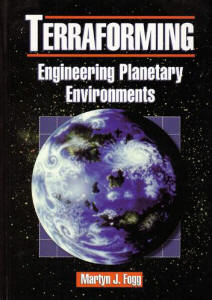|
|
|
by Martyn J. Fogg Ohio Aerospace Institute at NASA Lewis Research Center
from
TheTerraformingInformationPages
Website
Terraforming is the concept of altering
the environment of a planetary surface to make it suitable for
(terrestrial) life.
His references are quite thorough, and he is quite meticulous to credit the originator of each idea he mentions, so if you need more, you know where to go to look it up.
It's published, oddly enough, by the Society of Automotive Engineers. Why the SAE?
In explanation, Martyn says, SAE considers themselves to be first and foremost an engineering organization, and terraforming - planetary engineering - is engineering on the largest scale. Martyn Fogg is a regular writer of "science fact" articles for Analog, and the book reads quite smoothly.
He starts with a review of the development of terraforming in science fiction, particularly crediting,
Note that these beat by over a decade
the first scientific discussions of terraforming, Sagan's proposal
to terraform Venus in 1961, and the proposals to terraform Mars by
Burns and Harwit, and (independently) Sagan, in 1973.
His next chapter discusses environmental
modifications of the Earth, both incidental, and deliberate (i.e.,
solar shields to counter greenhouse warming.)
To his credit, after a long discussion of the possibility of "gentle" terraforming of Mars, he then discusses the very likely case that Mars is not in a such metastable state, and discusses "hard" terraforming, with a wide analysis of techniques such as nuclear mining, cometary impact, importing volatiles from icy moons, and enhancing solar radiation. He closes with an example terraforming scenario using all the tools available.
Of particular interest is his analysis of time scales.
His terraforming example requires roughly 200 years to reach the stage where simple anaerobic microorganisms and algae can survive, and as much as seven thousand years to completely terraform to a human-breathable atmosphere.
A long term project indeed!
We now know that the temperature of Venus is significantly hotter, the atmospheric pressure tremendously higher, and the chemical environment a lot harsher, than was thought in the pre-Pioneer days. Venus has just too damn much atmosphere.
He also points out that, even if it were possible to engineer organisms to sequester the carbon dioxide from the Venus atmosphere, the process would take between eleven thousand and 1.1 million years, depending on how optimistic one is about how efficient photosynthesis could be made to become.
Nevertheless, many science journalists (e.g., Adrian Berry) have continued to plug the "easy" terraforming of Venus by "just dropping a handful of algae into the atmosphere", and Fogg rather thoroughly debunks their optimism.
Terraforming Venus is hard. His
discussion covers most of the possibilities for dealing with
atmosphere of Venus, ranging from ablating it away with myriad
asteroidal impacts, to freezing it out with solar shields.
He then briefly discusses ever further
out ideas, including moving planets, turning Jupiter into a star,
and even the possibility of moving stars. OK. Now to be critical.
I wouldn't call it a textbook; it reviews the subject,
but doesn't attempt to teach the reader the techniques of analysis.
In other words, having read the book the readers will be familiar
with what has been calculated by others, but will not have the calculational tools to analyze terraforming calculations themselves.
There was no description of methods used to calculate the amount of greenhouse warming. A description of the greenhouse effect ought to include spectra, show a formula for integrating over the spectrum to compute total heat balance, and discuss the effect of optical depth. The book does not do this, and in fact never even gives a simplified model to calculate the amount of greenhouse warming.
He does, however, include a useful
empirical equation (unfortunately applicable only to Mars), to
calculate the combined effect of water and CO2 greenhouse
effect on overall surface temperature.
This is a pity, since it allows him to avoid asking the tricky question of how little atmospheric nitrogen an ecosystem actually requires. Nitrogen is a tough problem for Mars, which is nearly absent of N, as far as we can tell from all the information we have at the present.
Fogg postulates huge reserves in the
form of of nitrate deposits, but I must point out that there is as
yet no real evidence for such deposits, and it is quite possible
that nitrogen on Mars is simply not there.
I would have liked the flow better if he had put re-engineering Earth last, with the emphasis that we need to study, understand, and experiment, and make our mistakes on other planets first before embarking to mess with the one we live on.
He could have emphasized how we
understand greenhouse effect based on our studies of Venus; how the
"nuclear winter" scenario was proposed based on studies of the
effects of global dust coverage of Mars.
One of the proposals he discusses, for example, was to increase the spin of Venus using three quadrillion objects circulating between Venus and the sun every 2 hours, each traveling at 10% of the speed of light. I would personally have put that into the "fringe concepts" section, myself.
However, that's only a minor quibble.
Fogg uses the "fringe concepts" pigeonhole to discuss the really far-out concepts.
|


